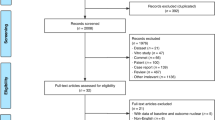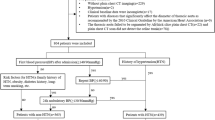Abstract
Serum angiotensin-converting enzyme (SACE) in 141 patients with newly detected primary lung cincer was 22.1 +/- 6.1 nmol/ml/min (mean +/- s.d.); lower than in healthy controls (24.4 +/- 6.2 nmol/ml/min, P less than 0.02). No correlation was found between SACE and sex, age, site of cancer, histological type, or lung function. After subdivision of the patients according to increasing SACE levels: less than 16.0 (mean SACE of lung cancer--s.d.), 16.0-22.0, 22.1-28.2 and greater than 28.2 nmol/ml/min (mean SACE of lung cancer + s.d.) there was a strong association (P less than 0.001) between SACE level and the proportion of patients who were radically operated without relapse during 8-22 months follow-up. None of 23 patients within the lowest SACE range were cured, even though 7 were referred for operation after preoperative examination. In contrast, 10/25 patients (40%) within the highest SACE range were cured. The results suggest that low SACE is associated with poor prognosis in lung cancer, even in patients who are judged as being operable on preoperative evaluation, and measurement of preoperative SACE in lug cancer may be a useful prognostic indicator in this disorder.
This is a preview of subscription content, access via your institution
Access options
Subscribe to this journal
Receive 24 print issues and online access
$259.00 per year
only $10.79 per issue
Buy this article
- Purchase on Springer Link
- Instant access to full article PDF
Prices may be subject to local taxes which are calculated during checkout
Similar content being viewed by others
Rights and permissions
About this article
Cite this article
Rømer, F. Angiotensin-converting enzyme and its association with outcome in lung cancer. Br J Cancer 43, 135–142 (1981). https://doi.org/10.1038/bjc.1981.21
Issue Date:
DOI: https://doi.org/10.1038/bjc.1981.21
This article is cited by
-
Risk of lung cancer and renin–angiotensin blockade: a concise review
Journal of Cancer Research and Clinical Oncology (2021)
-
Direct radioimmunoassay of angiotensin-converting enzyme in sera from patients with pulmonary diseases
Lung (1987)
-
Angiotensin-Converting-Enzym-Aktivit�t w�hrend zytostatischer Therapie bei Patienten mit prim�r inoperablem Bronchialkarzinom
Klinische Wochenschrift (1983)
-
Serum angiotensin converting enzyme in pulmonary disease
Lung (1982)



